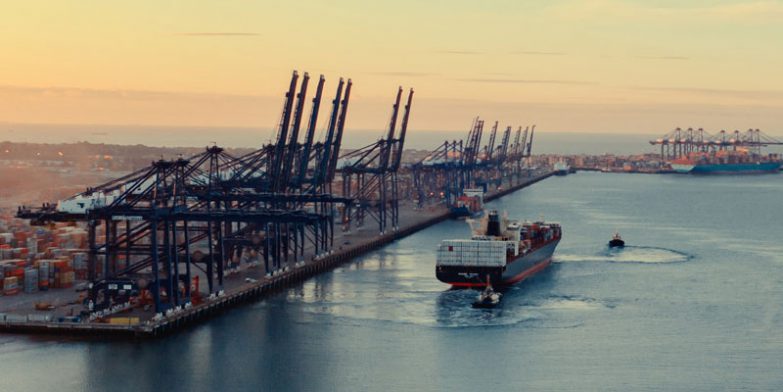
With 4.9 million TEU in new build container shipping due to be delivered from 2023 to 2024 and Europe’s GDP slowing to 0.7%, capacity should be top of mind for the global shipping lines, but the number of blank sailings on the Transpacific and Asia-Europe trades have actually dropped sharply in recent months, though there is an indication of a new increase to the US West Coast.
OCEAN
With 4.9 million TEU due to be delivered from 2023 to 2024 capacity will be top of mind for the global shipping lines, as rates sink to pre- pandemic levels and yet more blanked sailings are announced.
Maersk and MSC announced last month they would be adding nine new vessels into the Asia-Europe trade, but that these services would be moving up to three days slower than before, thus absorbing all the new capacity.
During the COVID pandemic the container shipping lines increased average sailing speed by 4% to meet strong demand and create spare time, because of widespread port congestion.
In the first quarter of 2023 the average sailing speed has come back down 4% year-on-year and could drop a further by 10% before 2025, to absorb capacity that would otherwise be surplus.
The Shanghai Containerised Freight Index (SCFI) covering export spot rates ex Shanghai had some upward momentum in the previous month and remains higher than despite some recent setbacks.
Export rates to North America have also risen, mainly to the US West Coast, but remain lower than earlier in the year. Rates to other regions have remained steady or continued to fall.
Atlantic headhaul rates declined at the start of the month and while the rate is down 50% compared to its pandemic peak, it it is still 63% higher than the corresponding period in 2019 before the pandemic.
The drop of 50% compared to the pandemic peak is not much compared to other major trades: Asia-North Europe is down 90% compared to peak; Asia-Med down 84%; Asia-US West Coast down 86% and Asia-US East Coast down 82%.
AIR
Air cargo tonnage and rates fell against the start of June, with volumes down 4% and rates down 1% on a weekly basis, while average pricing decreased, on a fortnightly basis, from all of the main origin regions, with rates outbound Europe to Asia Pacific showing the most notable drop of 4%.
Chargeable weight in the two-week period, year on year, was down 8% – with ex-North America down 18%, ex- Europe down 9%, and ex-Asia Pacific down 6%. Traffic ex-Middle East & South Asia is up 6%, YoY, however, with capacity up 11% overall and up 29% in Asia Pacific.
Many trade-lanes are seeing yields below 2019 levels, with high levels of transatlantic belly-hold capacity and parts of South-east Asia seeing passenger services increase substantially, while China and Hong Kong PAX services are growing more slowly.
Additional capacity is up by 13.4% compared to April 2022.
Cargo revenues are 40% higher than they were in 2019, but airline revenues are being driven by passengers again, with worldwide average cargo rates 38% below their levels this time last year.
While demand remains sluggish, industry optimists predict an acceleration of demand in 2024, while 2023 looks like hard work for the carriers, with much higher input costs, which they will struggle to absorb without revenues.
ROAD
The early part of the year is a traditionally a fairly quiet period in road freight transport, but the decline in 2023 is striking, especially in spot prices, which are a good indicator of supply/demand balance.
On average, spot rates declined much faster than contract rates, in line with the decline in consumer demand within European economies, which reduces the immediate pressure on spot market rates, as detailed in the most recent Ti/Upply/IRU market report.
Seasonally adjusted average monthly consumption figures are falling year-on-year by 6% in Germany, 3.9% in France, 2.8% in Italy, and 4.3% in the United Kingdom.
With wages generally not rising to the same extent as prices, the erosion of purchasing power is weighing heavily on consumption, even if the inflationary phenomenon began to ease in many territories at the beginning of 2023.
Overall, demand for intermediate and capital goods remains stable.
Carrier costs have increased substantially. Fuel prices were a major inflation factor in 2022, when the conflict in Ukraine broke out, but have since fallen sharply, with a decrease of 9% in the first quarter of 2023 compared to the previous period.
The latest data from the TEG Price Index reveals that the average price- per-mile for haulage and courier vehicles rose 0.7% during May. Year on year, there was a 1.2% increase, pushing the index to a record high for the month of May.
Whatever challenges your supply chain may face, our commercial vehicle fleet and the price and capacity agreements we have in place with our long-term partner air and ocean carriers mean that we continue to deliver resilient and reliable supply chain solutions.
Our purchase order management and supply chain tracking technology support the most demanding global trading regimes, providing transparency and control.
EMAIL Andy Costara to learn more and see how our technology can support your supply chain.





